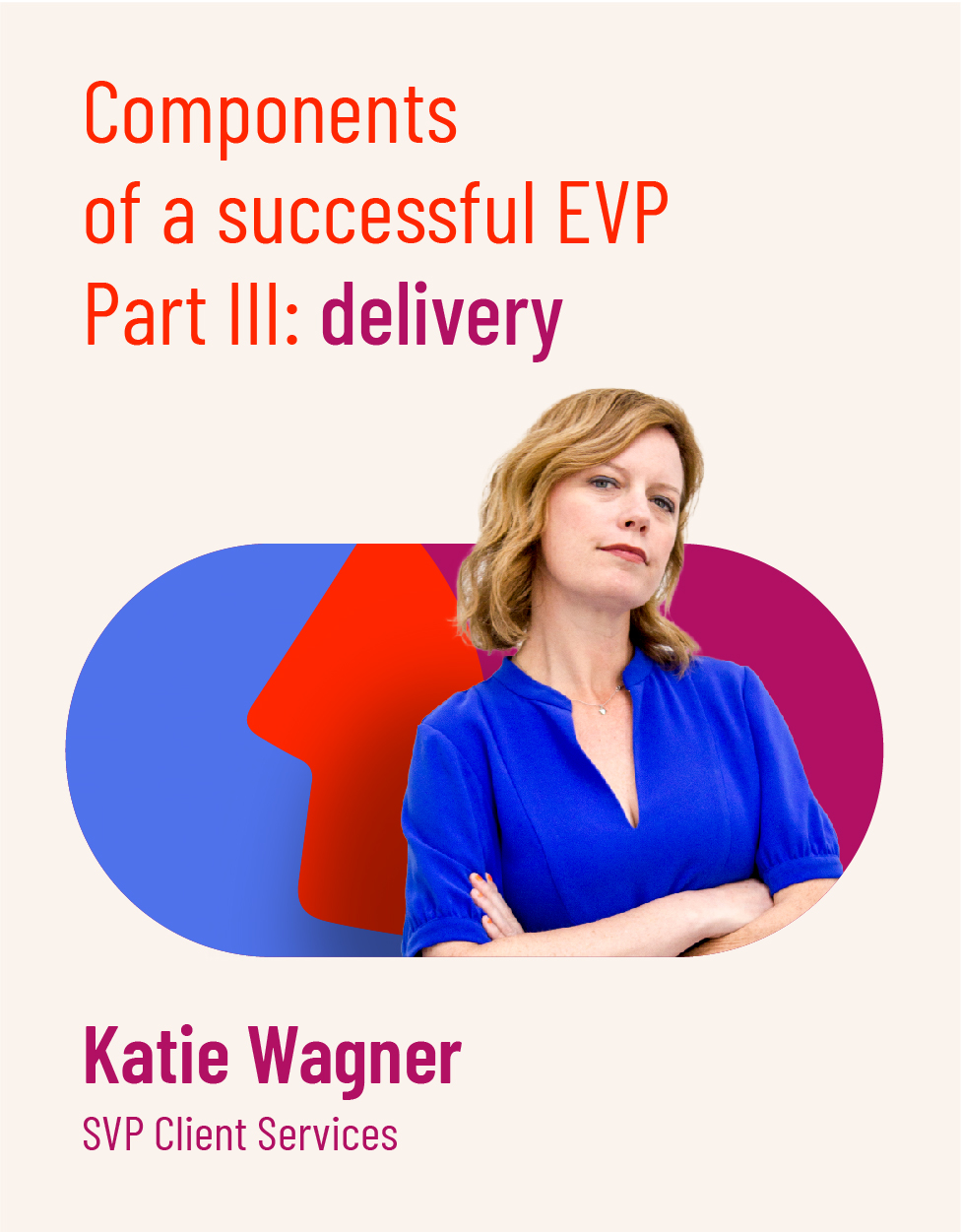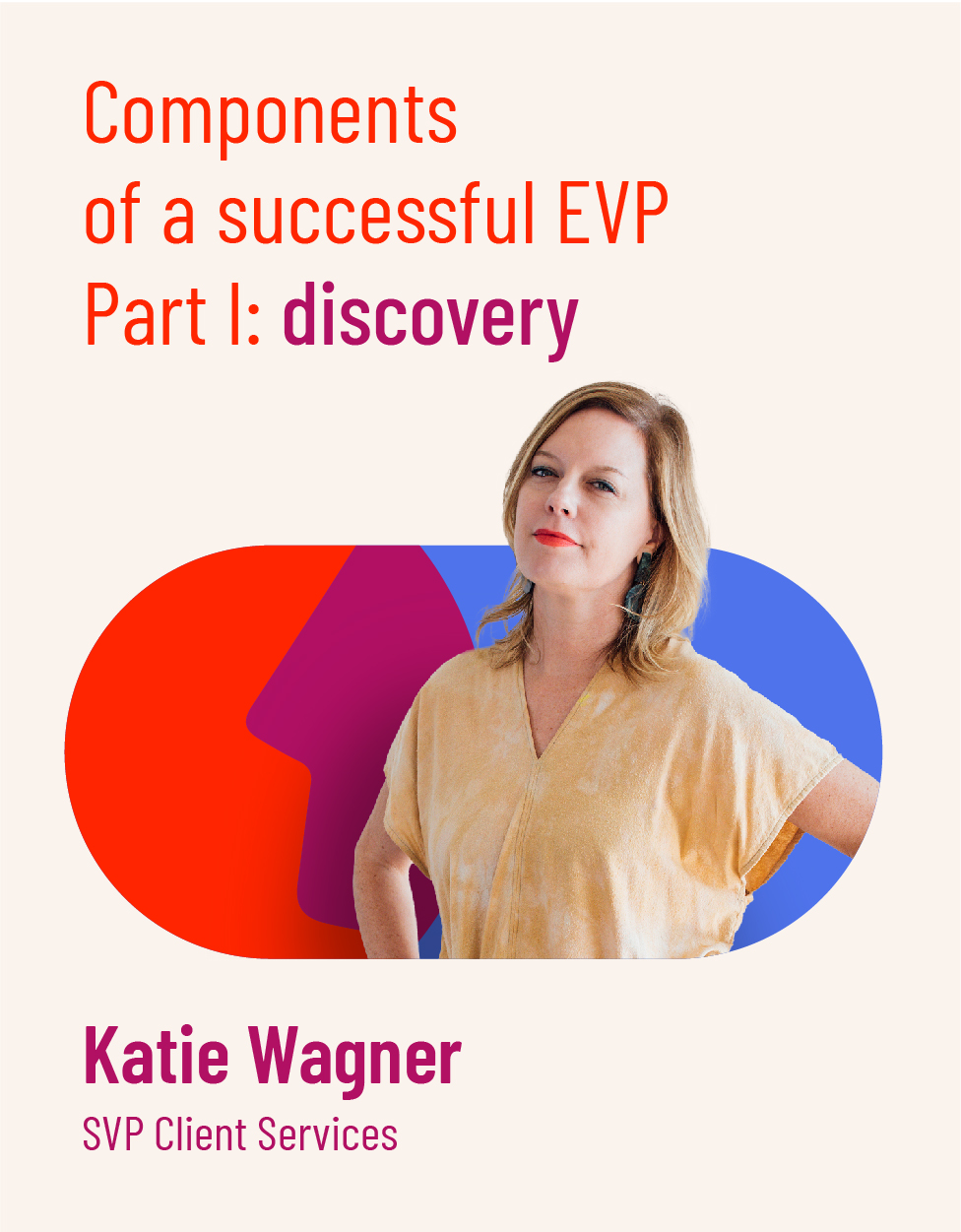Components of a successful EVP—Part II: strategy

After developing your employee value proposition (EVP) opportunity perspective through extensive research, it’s time to start building the actual strategic framework for your EVP.
This framework is the living document codifying the promised value of working at your organization that’s stated to employees and candidates. It guides communications shared along your candidates’ and employees’ journeys, and it informs future decisions and investments to help ensure your employee experience continually aligns with the organization’s goals and employees’ and candidates’ needs and wants.
And when the framework is developed through co-creation, it brings alignment with all EVP stakeholders.
The purpose of your EVP strategic framework
Ultimately, when your EVP is expressed to your current and future employees, it is the equivalent of your brand’s promise and messaging to customers—with both iterations aligned to the brand’s singular, overarching north star (i.e., purpose, vision, brand aspiration) adapted for context and audience.
However, your EVP’s strategic framework isn’t employee-facing outside of specific roles (e.g., leadership, HR, recruitment). Instead, it’s a living document guiding messaging, decision-making and investments to ensure that the promised value of working at the organization is adhered to.
For example:
- Internal communications or HR personnel craft messaging and use storytelling techniques influenced by the framework when creating recruitment or internal communications that continually reinforce employees’ and candidates’ understanding of the EVP.
- Leadership uses the framework to make investments in employee programs that align with the strategic framework, which might include:
- Training opportunities for career advancement
- Perks like gym memberships or rideshare app compensation
- Work schedule flexibility
- Additional services covered by company-provided health insurance
Swarming for co-creation
A successful EVP requires collaboration and alignment across multiple parties, with the various stakeholders providing their own insight. For example, leaders from HR and marketing offer complementary perspectives regarding what types of information must be communicated to employees and how it’s best delivered.
Different perspectives achieve the most through collaboration, and the best means for bringing them together to co-create the EVP involves “swarming.” This process leverages divergent and convergent thinking—with participants individually (or in small groups) building pieces of the framework based on the accumulated research and the employee experience the organization aims to deliver and then working together to reach consensus.
Most importantly, the Swarm needs to determine and align:
- The ultimate value the organization delivers to employees
- Who its employee believers are and what defines them (and their psychographics)
- The “core pillars” supporting the authenticity and delivery of the organization’s value proposition
Through this process, the entire group can quickly and effectively build the organization’s definitive EVP strategic framework.
Building your EVP’s strategic framework
An EVP’s strategic framework comprises:
- A strategy statement
- Five “pillars”
- Pillar-specific supporting statements
- EVP activation examples demonstrating the promised value’s tangible delivery (i.e., “proofs”)
The strategy statement
The strategy statement is the summation of the EVP. More specifically, it’s the umbrella condensing the EVP into a single strategy line based on:
- Supporting the company’s purpose (or mission)
- Authenticity to the organization
- Differentiation from other organizations
- The value employees and candidates seek from the company in exchange for their best work
And whenever employee- and candidate-facing communications are created or employee experience decisions are made, they must be scrutinized against this statement. In that sense, it acts as the primary filter for everything and anything related to a brand’s employee experience.
Your EVP’s five pillars and their supporting statements
An EVP’s five pillars represent categories demonstrating the strategy statement in action:
- Rewards: The compensation, benefits and other perks employees receive for their work
- Opportunity: The career progression paths available to employees and the support they receive when pursuing them
- Company: The organization’s reputation and history—or the prestige, respect and pride associated with peoples’ employment at the company
- Values and culture: The experience shared by the employee community
- The work: The inherent value of contributing to the company’s purpose and found in employees’ work
Associated with each of these pillars is a supporting statement, which bears a strong similarity to the overarching strategy statement. In a single sentence, they encapsulate the organization’s perspective on or approach to how the EVP is delivered with respect to that category.
Proof points
Within the EVP’s strategic framework, proof points consist of pillar-specific examples. These are the actual reasons to believe that support the company’s value promised to current and future employees. They can include programs, initiatives, policies, values, awards and company accolades.
For example, proofs might resemble the following:
- A mentorship program, where every new employee is assigned a mentor that helps them succeed at the company and in their own career aspirations, with one hour set aside for them to meet every two weeks (demonstrating opportunity at the company).
- A policy dedicating a set annual investment to providing employees with the resources and tools that enable them to perform their best work (demonstrating a company’s commitment to maintaining a “best-in-the-industry” reputation).
- A charitable program where the organization follows through on its values by supporting time off for related volunteer work or donating to appropriate nonprofits (e.g., portion of sales, matching employees’ independent efforts).
EVP adjustments over time
As a living document and with such universal application, your EVP’s strategic framework must be flexible. The employee experience messaging it influences should adapt as needed to maintain alignment with its promised value regardless of specific audiences, contexts or content (e.g., resource allocation decisions, messaging guidelines).
And—over time—the organization will continually reference the EVP’s strategic framework to determine gaps between the value promised to employees and candidates and the value actually delivered to them. Then, employee experience decisions and investments can be made based on the strategic framework to remedy those gaps.
In practice, this means the strategic framework’s strategy statement, pillars and supporting statements rarely—if ever—change. But, as tangible EVP activations, the proofs will adapt as needed.
Your EVP’s strategic framework—employee experiences’ most valuable tool
Your EVP strategy—and particularly the strategic framework as a living document—is the most important tool when it comes to delivering on the value promised to employees and candidates in exchange for their best work. This is because it guides every individual communication, decision and investment to ensure they are communicating and delivering the value of working at the organization.
Being authentic is the foundation for the relationships employees and candidates form with an organization as an employer. And without it, attracting top talent, deepening employee brand belief and improving the organization’s reputation as an employer will always remain substantial challenges.

